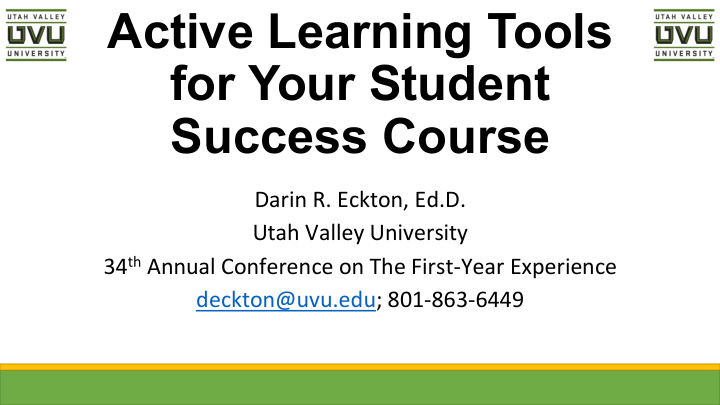



Active Learning Tools for Your Student Success Course Darin ¡R. ¡Eckton, ¡Ed.D. ¡ Utah ¡Valley ¡University ¡ 34 th ¡Annual ¡Conference ¡on ¡The ¡First-‑Year ¡Experience ¡ deckton@uvu.edu; ¡801-‑863-‑6449 ¡
Agenda • Modeling ¡AcMve ¡Learning ¡(Look ¡for…) ¡ • TheoreMcal ¡FoundaMons ¡ • Idea ¡GeneraMon ¡& ¡CollaboraMon ¡ • Discussion ¡& ¡Takeaways ¡ WiFi: ¡Omni ¡MeeMng ¡( this ¡is ¡a ¡temp ¡login ) ¡ Username: ¡Omni2015 ¡ ¡ ¡Password: ¡dallas2015 ¡
Guidelines • What ¡is ¡at ¡least ¡one ¡good ¡way ¡( that ¡has ¡ worked ¡for ¡you ) ¡that ¡helps ¡you ¡get ¡the ¡ a^enMon ¡of ¡your ¡students ¡when ¡talking/ doing ¡group ¡work? ¡ • Do ¡you ¡like ¡giving ¡a ¡‘Mme’ ¡warning? ¡
Opening Activity • With ¡somebody ¡you ¡don’t ¡know , ¡take ¡1 ¡ minute ¡to ¡introduce ¡yourself, ¡share ¡good ¡ news, ¡challenges, ¡favorite ¡FYE ¡moment, ¡etc. ¡ THEN… ¡ • Text ¡darineckton ¡to ¡22333 ¡(you ¡won’t ¡get ¡ spammed) ¡for ¡the ¡next ¡acMvity ¡
More Activities • www.polleverywhere.com ¡ • If ¡you ¡didn’t ¡already, ¡text ¡darineckton ¡to ¡ 22333 ¡(you ¡won’t ¡get ¡spammed) ¡for ¡ these ¡quesMons ¡
Theoretical Foundations • Daniel ¡Pink, ¡2009 ¡ Bloom’s ¡Taxonomy ¡ Maryellen ¡Weimer, ¡ • Autonomy ¡ 2013 ¡ • Mastery ¡ ¡ • Purpose ¡ Consider ¡the ¡following: ¡
Theoretical Foundations continued • “What ¡can’t ¡be ¡accomplished ¡with ¡policies ¡and ¡requirements, ¡we ¡go ¡ aher ¡with ¡an ¡array ¡of ¡extrinsic ¡moMvators. ¡We ¡use ¡quizzes ¡to ¡keep ¡ students ¡up ¡with ¡reading, ¡offer ¡extra-‑credit ¡points… ¡award ¡bonus ¡ points… ¡where ¡students ¡get ¡points ¡for ¡every ¡desirable ¡acMon ¡and ¡have ¡ points ¡docked ¡for ¡undesirable ¡acMons.” ¡ ¡ • “These ¡systems ¡distract ¡students ¡from ¡what ¡should ¡be ¡moMvaMng ¡their ¡ learning” ¡(Pike, ¡2011, ¡p. ¡4). ¡“Grades ¡moMvate ¡gelng ¡grades.” ¡ ¡ • “The ¡more ¡decisions ¡we ¡make, ¡the ¡less ¡able ¡they ¡are ¡to ¡make ¡ decisions.” ¡ • “The ¡more ¡control ¡we ¡exert, ¡the ¡more ¡controlled ¡they ¡become.” ¡ ¡
Idea Generation & Collaboration -‑What ¡are ¡some ¡things ¡you ¡do ¡to ¡invite ¡ students ¡to ¡engage ¡in ¡high ¡cogniMve ¡ tasks? ¡ ¡ -‑What ¡systems ¡do ¡you ¡have ¡in ¡place ¡that ¡ may ¡distract ¡or ¡control ¡students, ¡or ¡that ¡ focus ¡on ¡extrinsic ¡moMvators? ¡Why? ¡ ¡ • THINK ¡ – ¡PAIR ¡– ¡SHARE ¡ ¡
Active Learning Assignments • What ¡do ¡you ¡know? ¡(pre-‑assessment) ¡ • Readings ¡ • Lessons ¡(in/outside ¡class) ¡ • ApplicaMon ¡(Mme ¡can ¡be ¡instrucMve) ¡ • NegoMate ¡assessment ¡rubrics ¡with ¡class ¡ • ReflecMon/Process ¡(post-‑assessment) ¡ • Takeaways/Show ¡& ¡Tell ¡(Mme ¡to ¡share) ¡ • A ¡word ¡on ¡late ¡work ¡(remember ¡Weimer) ¡
Student Examples - Motivation
Student Examples – Goal Map
Student Examples – Note Taking
h^ps://acMvelearningtools.wikispaces.com/ ¡
Discussion & Takeaways • What ¡did ¡you ¡see, ¡think, ¡feel ¡or ¡ experience ¡with ¡acMve ¡learning? ¡ • What ¡is ¡at ¡least ¡one ¡takeaway ¡(one ¡thing ¡ you’ll ¡do ¡differently/to ¡improve)? ¡ • Other ¡comments ¡ (complete ¡eval. ¡form, ¡por ¡favor) ¡ ¡
Recommend
More recommend